The September 2013 S&P Case Shiller home price index shows a seasonally adjusted 13.3% price increase from a year ago for both the 20 metropolitan housing markets and the top 10 housing marketso. America is now only 20% away from the peak of the housing price bubble and the two indexes are comparable to May 2004 levels Graphed below is the yearly percent change in the composite-10 and composite-20 not seasonally adjusted Case-Shiller Indices.

This is the largest annual increase in home prices in seven years as it was last month. Home prices only increased greater in February 2006, right before the start of the great housing bubble collapse. Below is a graph of the annual change in the S&P Case-shiller home price composite-20 and composite-10 indexes. Notice how in March 2006, annual increases are at a cusp and early 2006 is the start of a long slide down. We have housing bubble déjà vu, so much so S&P mentioned it in this month's press release:
The strong price gains in the West are sparking questions and concerns about the possibility of another bubble.
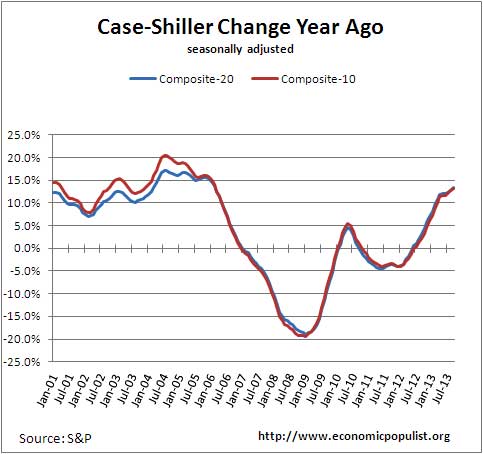
S&P also produces a third quarterly national index. S&P is using the not seasonally adjusted national index when they report Q3 2013 home values are up 3.2% from Q2 2013, although the seasonally adjusted change is 2.4% between quarters. Below is the national index, not seasonally adjusted (blue), which are used as the headline numbers, against the seasonally adjusted one (maroon).

Below is the quarterly national index percent change from a year ago, now at 11.2%. The national index also shows soaring prices and a return to not affordable housing.
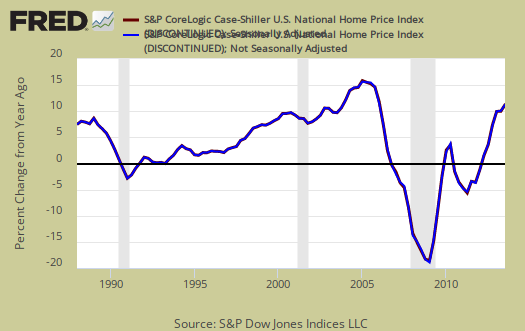
Below are all of the composite-20 index cities yearly price percentage change, using the seasonally adjusted data. Las Vegas is a bubbling cauldron of trouble as prices have increased over 29.2% from a year ago. Nevada has the worst unemployment rate in the nation, so it is unfathomable these are real people buying these homes and not investors and flippers. Generally speaking the West is on fire with increasing prices and we know wages and income for most Americans cannot afford these home prices in spite of very low mortgage rates.

S&P reports the not seasonally adjusted data for their headlines. Housing is highly cyclical. Spring and early Summer are when most sales occur. See the bottom of this article for their reasoning. For the month, the not seasonally adjusted composite-20 percentage change was 0.7% whereas the seasonally adjusted change for the composite-20 was 1.0%. The monthly not seasonally adjusted composite-10 percentage change was 0.7%, whereas the seasonally adjusted composite-10 showed a 0.9% increase. This is fall, so the not seasonally adjusted increase should be less than the seasonally adjusted composite-20. The below graph shows the composite-10 and composite-20 city home prices indexes, seasonally adjusted.
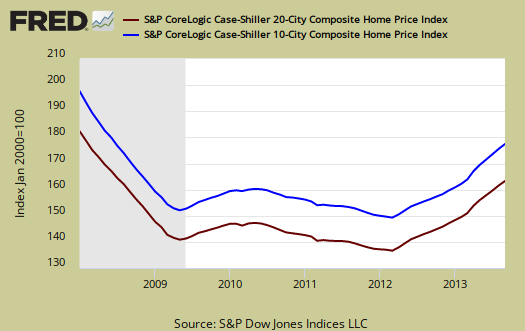
Prices are normalized to the year 2000. The index value of 150 means single family housing prices have appreciated, or increased 50% since 2000 in that particular region. Case-Shiller indices are not adjusted for inflation, but they created a graph showing what prices would be if they were adjusted for inflation. Their graph pretty much follows the above since inflation has been so tame for so long.
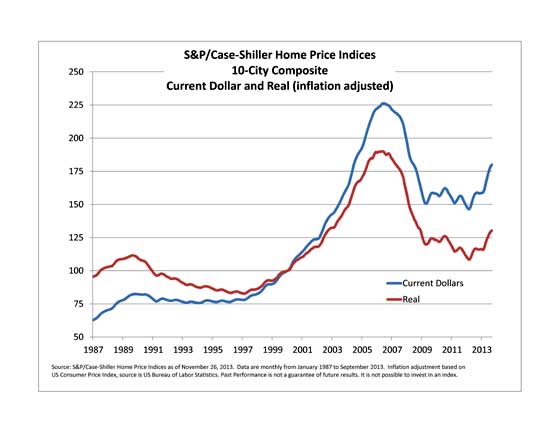
Some in the press use the seasonally adjusted data, and others do not. Some report the monthly change, others the annual change. To make matters worse, some in the press do not specify which statistic they are quoting from S&P. Below are the seasonally adjusted indices for this month. The index itself tells you what has happened to home prices, per city, from the year 2000. Only Detroit is below their 2000 home price values. Los Angeles home prices have doubled since 2000 while they have one of the highest unemployment rates in the nation, 9.7%. Clearly most cannot afford a home in LA, so one must wonder how these increases are sustainable.
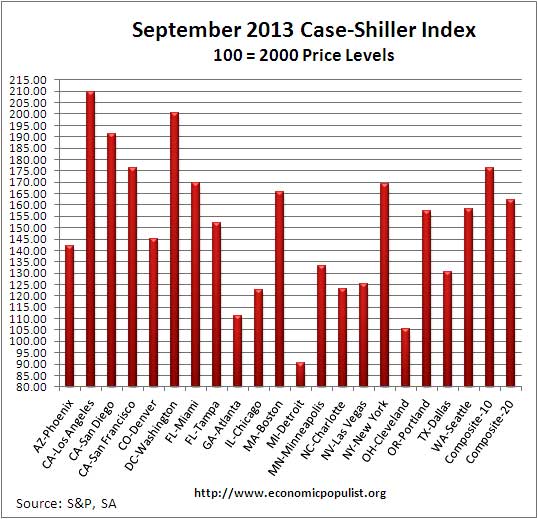
S&P mentions other statistics should imply slowing growth, yet do not address the increasing prices in their press release beyond mentioning the keyword bubble.
Other data suggest a market beginning to shift to slower growth rather than one about to accelerate. Existing home sales weakened in the most recent report, home construction remains far below the boom levels of six or seven years ago and interest rates are expected to be higher a year from now
We see the problem being wages and employment and thus we believe there is a new bubble forming. Only when incomes come into alignment with home prices will we feel the residential real estate market is healthy and sustainable.
To Season or Not to Season, That is the Question:
The S&P/Case-Shiller Home Price Indices are calculated monthly using a three-month moving average and published with a two month lag. Their seasonal adjustment calculation is the standard used for all seasonal adjustments, the X-12 ARIMA, maintained by the Census.
So, why would S&P report the not seasonally adjusted data? According to their paper on seasonal adjustments, they claim the not seasonally adjusted indices are more accurate. It appears the housing bubble burst screwed up the cyclical seasonal pattern. What a surprise, although those steep cliff dives are now going back to 2009, one would think the seasonally adjusted data would now start to converge back to it's cyclical, seasonal pattern.
The turmoil in the housing market in the last few years has generated unusual movements that are easily mistaken for shifts in the normal seasonal patterns, resulting in larger seasonal adjustments and misleading results.
To see S&P's argument in action, look at the below graph. The maroon line is the seasonally adjusted national index, reported quarterly. The blue line is the not seasonally adjusted national index. As we can see before the housing bubble burst, we see a typical cyclical pattern difference between the seasonally adjusted and not seasonally adjusted data points. Yet after the bubble burst we see large swings, which would throw off a seasonal adjustment adaptive algorithm. This is going to become a major question among statisticians, how does one adjust for seasonality in the face of tsunami like economic events? Is it now long past the housing bubble collapse, yet we can see the seasonal adjustments still are not completely matching up from the year ago percent changes, which implies they are still off statistically.
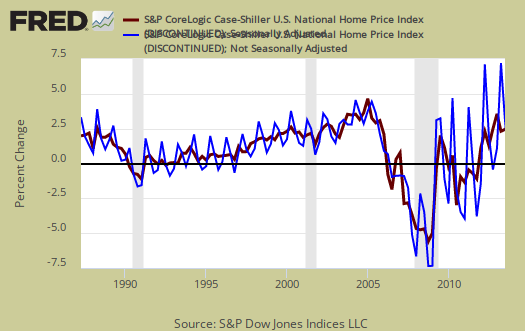
Not seasonally adjusted data can create more headline buzz on a month by month basis due to the seasonality of the housing market. S&P does make it clear that data should be compared to a year ago, to remove seasonal patterns, yet claims monthly percentage changes should use not seasonally adjusted indices and data. This seems more invalid than dealing with the statistical anomalies the massive housing bubble burst caused. Below is the seasonally adjusted and not seasonally adjusted Composite-20 Case-Shiller monthly index, for comparison's sake.

For more Information:
S&P does a great job of making the Case-Shiller data and details available for further information and analysis on their website.
Here is our Case-Shiller past overviews as well as the overviews of residential real estate statistics.

the press talks about underwater home owners
Yet the people who managed to hang onto their homes and recover simply make the spread of income inequality that much worse and those buying a 1st home or trying to recover from foreclosure don't have a prayer's chance with increasing prices. In other words, most of the press do not tell the whole story on soaring home prices.
houses arent meant to be lived in anyway
isnt it curious that the report continues to refer to changes in house prices as "returns", as if a house were not a home, but rather an investment vehicle which could be flipped as soon as a profit could be realized...ie, they report that "twelve cities posted double-digit annual returns..with Las Vegas gaining 29.1% year-over-year followed by San Francisco at 25.7%, Los Angeles at 21.8% and San Diego at 20.9% and that "San Francisco and Los Angeles showed their highest annual returns since March 2001 and December 2005".
rjs